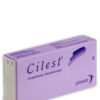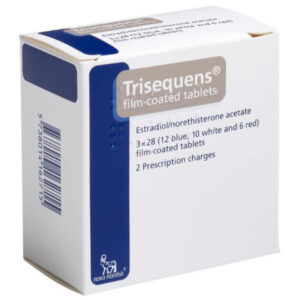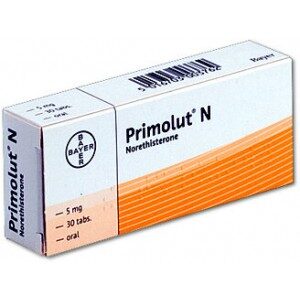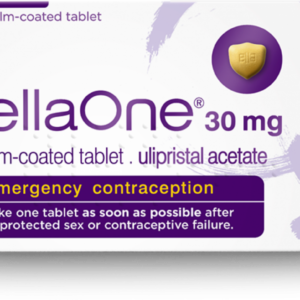Dianette
$19.99
Dianette is a combined oral contraceptive pill that also treats acne.
Treatment information
- Product Name: Dianette
- Manufacturer: Bayer
- Active Ingredient(s): Cyproterone acetate/Ethinylestradiol
- Administration: Oral
- Presentation: Tablet
- Available Strength: 2mg/35mcg
- Exemption: Prescription only
- Dosage: Take 1 tablet daily, at the same time each day
- Description: Dianette is a combined hormonal treatment for preventing pregnancy
- Drug Class: Oestrogen
- Alcohol Consumption: No influence
- When Pregnant: Do not take Dianette if you are pregnant. Speak to your doctor for further advice.
- When Breastfeeding: Do not take Dianette if you are breastfeeding. Speak to your doctor for further advice.
Buy Dianette In USA Online – Dianette For Sale Online
What is Dianette?
Dianette is a combined hormonal contraceptive pill that is also used to treat acne. When used correctly, combined contraceptive pills provide 99% protection against unwanted pregnancy.
While Dianette can protect you against unwanted pregnancy, it does not protect you against sexually transmitted infections (STIs) such as chlamydia, gonorrhoea or HIV. Condoms are the only form of contraception that can prevent sexually transmitted diseases.
Besides being an effective form of contraception, Dianette is also prescribed to women whose acne hasn’t responded well to other acne treatments such as antibiotics. Furthermore, Dianette helps to regulate periods, making them lighter and regular.
It is important to speak to your doctor before you take Dianette to make sure it is the right contraceptive pill for you. Your GP will evaluate the safety of Dianette for you based on your current health, family history and other medications you may be taking.
If you wish to order Dianette online, Prescription Doctor’s online pharmacy offers a quick and efficient service that allows you to get medicine delivered straight to your door.
How does Dianette work?
The pill contains an anti-androgen called cyproterone acetate and a synthetic oestrogen called ethinylestradiol. When combined, the active ingredient is known as co-cyprindiol.
Androgens, such as testosterone, are male sex hormones that are present in both sexes. These hormones play vital roles in the hair growth cycle and the production of an oily substance called sebum, which is secreted by sebaceous glands under the skin.
By reducing the amount of these male sex hormones (androgens), their effects on the female body are reduced. You may notice that your skin becomes noticeably less oily after using Dianette for a few weeks. This is the reason it is often prescribed for acne.
Ethinylestradiol is a synthetic progestogen, which mimics the natural hormone progesterone. This synthetic hormone prevents ovulation, which is the release of an egg from the ovaries during menstruation. This greatly reduces the risk of becoming pregnant when used correctly.
How do I take Dianette?
Dianette is taken as a 21-day pill. This means you take the pill for 21 consecutive days followed by a 7-day break.
You should start taking Dianette on the first day of your period. When taken on the first day of your menstrual cycle, you will be immediately protected.
The blister pack is marked with days of the week. Start with the correct day of the week and follow the directional arrows printed on the strip.
Take one pill daily. Swallow the pill whole with a glass of water.
Do not crush or chew the tablet.
It’s important to take the pill at the same time each day in order for it to be effective. If you have trouble remembering when to take medicine, set a reminder on your phone or store your medicine somewhere which will jog your memory.
Once you have completed a 21-day strip, you should have 7 consecutive days during which you should not take any pills. During these 7 days, you should experience a withdrawal bleed. If you’ve taken the pills correctly for the previous 21 days, you should remain protected during this 7-day break and therefore you don’t need to use another form of contraception.
After your 7-day break, you should begin a new strip on day 8 – even if you are still experiencing a withdrawal bleed. For example, if you take the final pill of one pack on a Saturday, you should start a new strip on Sunday.
Always start your new strip on time to remain protected. So long as you take Dianette correctly, you should begin each new strip on the same day of the week.
What should I do if I forget to take Dianette when I should?
If less than 12 hours have passed since your last pill was due, take it as soon as you remember and continue taking Dianette when you should. This may mean taking 2 pills on the same day, though this is unlikely to cause harm. You should remain protected if you take the forgotten pill within the 12-hour window.
If 12 hours or more hours have elapsed since you were due your pill, or if you have missed more than one of your pills, you may not be protected against unwanted pregnancy and should use an additional form of contraception, such as condoms, for 7 days. Take the last missed pill in the pack as soon as you remember and continue to take Dianette as you normally would. This may mean taking 2 pills on the same day, though this unlikely to harm you.
If you are late to begin a new strip of pills or increase your break to longer than 7 days, your protection may be reduced. If you had unprotected sex during the 7-day break, speak to your doctor or pharmacist for advice. You may need to consider emergency contraception. You will need to use an additional form of contraception, such as a condom, for 7 days.
What should I do if I take too much Dianette?
Accidentally taking more than one Dianette pill is unlikely to harm you, though it may increase your risk of side effects such as nausea, vomiting or vaginal bleeding. If you take more Dianette than you should, speak to your doctor.
Side effects and cautions
All medicines carry the risk of side effects, though not everybody experiences them. Understanding and remaining vigilant of side effects are vital to your health.
You must read the leaflet enclosed with your medicine. If you are unsure about any of the information presented in the patient information leaflet, speak to your doctor or ask a pharmacist for assistance.
You can read the patient information leaflet for Dianette online.
Do not take Dianette if you:
- are allergic to any of Dianette’s ingredients
- are breastfeeding
- are pregnant or think you might be pregnant
- are using another form of hormonal contraceptive
- have a condition that may raise your risk or blood clots
- have or had a blood clot in your leg (thrombosis), lung (pulmonary embolism), or anywhere else in the body
- have or had liver tumours
- have or had severe liver disease
- have or have had a disease that may be an indication of a future heart attack, such as angina, stroke or mini-stroke (transient ischaemic attack)
- have or have had a heart attack or stroke
- have or have had breast cancer
- have or have had migraines with visual disturbances
Side effects of Dianette include:
- Nausea
- Stomach pain
- Headache
- Depressive moods or mood swings
- Tender breasts
- Change in sex drive
- Enlargement of the breasts
- Rashes
- Vaginal or breast discharge
- Venous blood clot
This is not a full list of side effects associated with Dianette. The patient information leaflet enclosed with your treatment contains an in-depth list of known side effects, in addition to other important information regarding the safety of Dianette.
If you experience any side effects after taking Dianette, regardless of whether they are listed above or in the patient information leaflet, inform your doctor as soon as possible.
Risk of blood clots
Dianette has been shown to increase your risk of blood clots in those susceptible. If left untreated, blood clots can cause strokes and heart attacks. While taking Dianette, it is important to undergo regular checks with your doctor.
You are at a higher risk of blood clots while taking Dianette if you:
- are overweight
- are undergoing surgery in the near future
- have a high cholesterol
- have a history of blood clots in your family
- have diabetes
- have heart problems
- have polycystic ovary syndrome (PCOS)
- have recently had a baby
- have sickle cell disease
- have systemic lupus erythematosus
- smoke
If any of the above apply to you, speak to your doctor before you take Dianette. Your doctor may advise you to use an alternative contraceptive pill.
Allergic reaction
Do not take Dianette if you are allergic to co-cyprindiol, ethinylestradiol or any of the other excipients of the medicine.
If you experience an allergic reaction after taking Dianette, stop taking Dianette and seek emergency medical attention.
Signs of an allergic reaction include:
- Dry, red and cracked skin
- Itchy, red, watery eyes (allergic conjunctivitis)
- Raised, itchy, red rash (hives)
- Stomach pain, nausea, vomiting or diarrhoea
- Swelling of the face, lips, tongue or throat
- Tightness of the chest
- Wheezing or difficulty breathing
Pregnancy and breastfeeding
Do not take Dianette if you are pregnant, think you might be pregnant, or plan on starting a family in the near future.
If you become pregnant while taking Dianette, stop taking Dianette and speak to your doctor for further advice.
Do not take Dianette while breastfeeding.
Other safety information
Always read the
Do not take Dianette past the expiry date printed on the packaging. The date refers to the last day of that month.
Never throw unwanted or expired medicine away via household or water waste. You should take any unwanted or expired medication to your nearest pharmacy and ask them to dispose of it safely on your behalf.
Always keep medicine out of sight and reach from children and pets.
Frequently asked questions
Can I drink alcohol while taking Dianette?
Alcohol consumption is unlikely to impact the effectiveness of Dianette.
However, excessive alcohol consumption may increase your risk of side effects. If you vomit as a result of drinking alcohol shortly after taking Dianette, the hormones may not have been adequately absorbed by your body and you may not be protected.
Will Dianette affect my ability to drive or operate machinery?
Dianette should not impact your ability to drive or operate machinery.
If you experience dizziness, tiredness or visual disturbances after taking Dianette, do not engage in activities which require your undivided attention until you feel it is safe to do so.
What should I do if I experience vomiting or diarrhoea after taking Dianette?
Vomiting and very bad diarrhoea can reduce the effectiveness of the pill, as the hormones may not have been adequately absorbed by the body.
If you feel better within 12 hours of when you were due your dosage, follow the information under “What should I do if I lose a pill on the strip?”.
If you continue to suffer from vomiting or diarrhoea for 12 or more hours after taking Dianette, see “What should I do if I forget to take Dianette when I should”.
Further information on what to do can be found in the patient information leaflet enclosed with your medication.
What should I do if I lose a pill in the strip?
If you lose a pill, you have two options.
The first option is to take the last pill on the strip in replacement of the lost pill. Continue to take the rest of the pills on the strip on their proper days. While this will shorten your cycle by 1 day, it will not affect your protection. After your pill-free break, you will start a new strip 1 day earlier than before.
The second option is to take a pill from a spare strip then continue to take the pills on our current strip as you normally would. This method can be used if you do not wish to change the starting day of your cycle. Keep the opened spare strip in case you lose any further pills.
I missed a period – am I pregnant?
A missed withdrawal bleed could be an indication of pregnancy, though this is unlikely if you have been taking Dianette correctly.
If you miss a withdrawal bleed, start your next strip as you normally would. If you believe you may have put yourself at risk of pregnancy, by missing pills or taking a medicine that may reduce the effectiveness of Dianette, or if you miss a second withdrawal bleed, you should do a pregnancy test.
If you are pregnant, cease taking Dianette and speak to your doctor.
I want to start a family – how do I stop taking Dianette?
If you plan on having a baby, you can safely stop Dianette at any time.
When you stop taking Dianette, you should use another method of contraception, such as condoms, until you experience a period. This is because your doctor or midwife will require the date of your last natural period to estimate the due date of your baby.
If you get pregnant immediately after stopping Dianette, it will not harm your baby.
If you are unsure about stopping Dianette, speak to your doctor.
How soon after having a baby can I start taking Dianette?
You can start taking Dianette 21 days after delivering a baby, so long as you are completely mobile.
While you don’t have to wait for a period before starting Dianette, you will need to use an additional form of contraception, such as condoms, for the first 7 days of taking Dianette.
I currently take another hormonal contraceptive pill – how can I switch to Dianette?
For 21-day pills, start taking Dianette the next day after the end of the previous strip. While you will not have a withdrawal bleed until after your first strip of Dianette, you will be protected from the first pill.
For 28-day pills, begin Dianette the day after your last active pill. While you will not have a withdrawal bleed until after your first strip of Dianette, you will be protected from the first pill.
For progestogen-only pills (mini pill), begin Dianette on the first day of bleeding, even if you have already taken the mini pill for that day. You will be protected right away
Be the first to review “Dianette” Cancel reply
Related products
WOMEN'S HEALTH
WOMEN'S HEALTH
WOMEN'S HEALTH
WOMEN'S HEALTH
WOMEN'S HEALTH
WOMEN'S HEALTH
WOMEN'S HEALTH
WOMEN'S HEALTH












Reviews
There are no reviews yet.